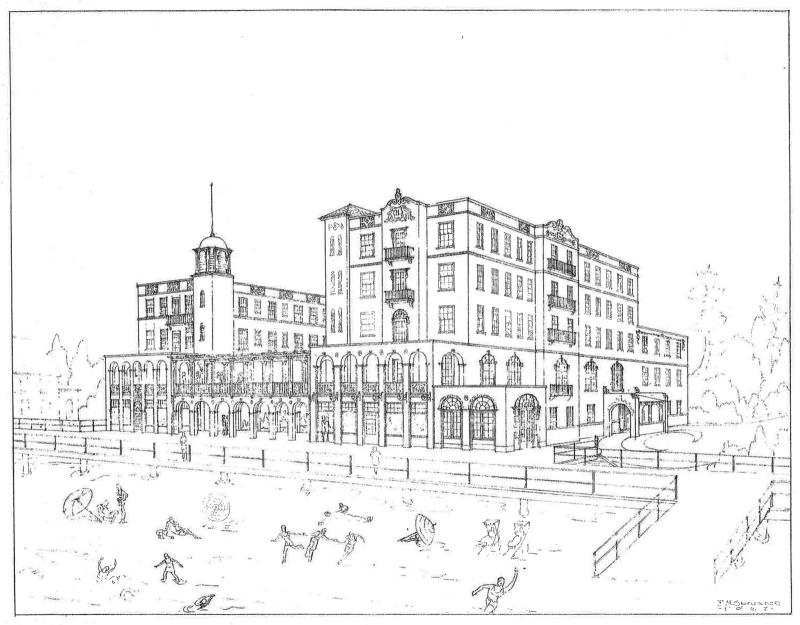In the 1920s, duPont dynamite helped drain Lake Gerar

Recent rains brought out a hatch of mosquitoes that buzzed and bit their way into many people's attention, along the coast and inland. It was a reminder that up until a century ago, mosquitoes were a serious problem in Delaware. So serious that at one point Irenee duPont of the famous DuPont Company resorted to the use of dynamite to help relieve the problem in the budding ocean resort known as Rehoboth Beach.
Barbara Dougherty brought me in a sheaf of papers a few years ago relating to some of the early history of the resort. Now deceased, Barbara in the 1960s worked at the Eleutherian Mills Hagley Foundation - where the DuPont Company manufactured explosives for a couple of centuries. Part of her job was to keep the duPont family genealogy.
In the process, she gathered correspondence relating to activities by the duPonts in the Rehoboth area.
The letters note that in 1921, Irenee duPont purchased more than 70 lots in The Pines area of town. Around Lake Gerar and along Oak Avenue, the lots had been plotted many years earlier but never developed. They were wooded with large pines and oaks and a holly understory, and were within just a couple of blocks of the Atlantic and Rehoboth's fine ocean beaches.
DuPont paid $4,200 for the lots - at an average price of about $50 per lot - and offered them to a number of friends and relatives. He stipulated that they must build cottages on the lots immediately as he was working to build the attractiveness of Rehoboth Beach as a summer resort and also wanted to provide work for contractors in the area.
He had two main concerns: one was mosquitoes in Lake Gerar, which at the time was little more than a mucky swamp; the other was erosion along the beach. DuPont went to work quickly on remedies. Both, he knew, might deter others from wanting to invest in the new resort.
A proposal to Rehoboth
Clearly knowledgeable about the power of his company's dynamite, duPont proposed to the commissioners of Rehoboth Beach - in spring 1922 - that he be allowed to break through the substrata of Lake Gerar and in so doing drain that mosquito-infested swamp.
His plan was to dynamite the lake bottom, breaking through centuries of accumulated sediment and muck, drain it of its fouled water and use a dragline excavator to fill in another section of the lake for a park. Then he would allow natural springs to refill the lake with the fresh water that gives the lake - along with Silver and Comegys at the south end of town - a unique geological circumstance along the East Coast.
Noting that duPont planned to undertake the work at his own expense - in return for which the city would keep the filled portion for a public park - Rehoboth's commissioners approved his plan in May 1922.
In June 1922, duPont paid Elmer Euvert of Harrington, Delaware $21.73 for the Lake Gerar blasting work which involved 33 pounds of dynamite procured from DuPont Red Cross Farm and Stumping Powders.
By 1927, his plan well underway, duPont also worked on enlisting the Boy Scouts in Rehoboth Beach to help out. In a June letter that year to Richard R. Francis in Rehoboth, duPont wrote: "I have written to Mr. A.D. Warner Jr. when transmitting a contribution to the Boy Scouts, to say that I think the Boy Scouts can do a piece of outdoor work which will be of great value to the community if they will put some time on searching out places where mosquitoes breed and destroy them.
Particularly in Rehoboth is this true. I have noticed large numbers of bottles and tin cans strewn on vacant lots and through the woods. These are notorious breeding places for mosquitos."
In the next several years, Mrs. Henry Thompson of Wilmington, whose family was one of the early investors in duPont's lots, led a major effort to drain salt marshes in Delaware to deal with mosquitoes.
After the Civilian Conservation Corps ditched the marshes in the early 1930s, the mosquito problem dissipated greatly and the resort's development took on a whole new energy. During the same time in the early 1920s, duPont was working with Delaware's Legislature to get the first set of groins and jetties built along Rehoboth's beach to retard erosion.
And then the construction of cottage bungalows began.
DuPont through this time had been working with Mrs. Frank DeArmond of Wilmington. She was Ann Marvel by birth and had grown up in Georgetown. As a result she had a personal interest in the development of Rehoboth Beach.
In April 1922, again working on many projects simultaneously, duPont asked DeArmond if she would oversee construction of three bungalows in Rehoboth. In return, he offered an interesting proposition. "Should work on that number proceed, I will give you my 'Robin's Egg' Cadillac runabout. I had intended to trade this in on a Cadillac Victoria, but knowing that you wanted it, held it out of the trade."
DeArmond took duPont up on his offer. Later, she became the wife of duPont relative Felix duPont who had moved to Rehoboth Beach. They built a large cottage on the shores of Lake Gerar, on lots acquired from Irenee. That Oak Avenue home was eventually bequeathed to the Episcopal Diocese of Delaware and, in accordance with her request, is still known today as the A. Felix duPont Memorial House.





















































